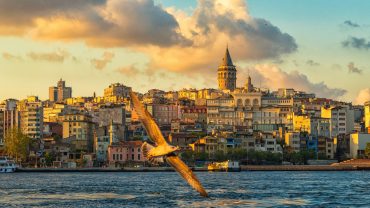Üsküdar (Turkish pronunciation: [ysˈcydaɾ]), traditionally known in Italian and English as Scutari (Skoutàrion, Σκουτάριον in Greek), and in classical antiquity known as Chrysopolis, is a large and densely populated district and municipality of Istanbul, Turkey, on the Anatolian shore of the Bosphorus. It is bordered on the north by Beykoz, on the east by Ümraniye, on the southeast by Ataşehir, on the south by Kadıköy, and on the west by the Bosphorus, with the areas of Beşiktaş, Beyoğlu, and Eminönü on the opposite shore. It is home to about half a million people. Üsküdar is also the usual name for the historic center of the municipality.
Üsküdar is a municipality within borders of Istanbul Metropolitan Municipality (büyükşehir). The municipality is subdivided into neighborhoods (mahalleler). The boundaries and names of the official neighborhoods change from time to time and sometimes do not correspond to historically recognized neighborhoods or to residents’ own perceptions.
The most prominent neighborhood is Üsküdar’s historic center (merkez), centered on the ferry docks and roughly corresponding to the current Mimar Sinan neighborhood (former Selmanağa, Tembel Hacı Mehmet, and İnkılap neighborhoods). This area includes large historic mosques, many businesses and markets, and is a transportation hub.
Other prominent neighborhoods include the former villages on the Bosphorus to the north of the historic center, Kuzguncuk, Beylerbeyi, Çengelköy, Kuleli, Vaniköy (now part of Kandilli), and Kandilli; the neighborhoods along the Bosphorus shore south of the historic center, Salacak, Harem (now part of Aziz Mahmud Hudayı), and Selimiye; and the mostly residential neighborhoods on the hilltops and hillsides, Doğancılar (now mostly part of Aziz Mahmud Hudayı), İmrahor (now part of Salacak), Selamsız (now part of Selamiali), Bağlarbaşı (now part of Altunizade), Altunizade, Acıbadem, Küçük Çamlıca, and Büyük Çamlıca (mostly in Kısıklı, Burhaniye, and Ferah).
Salacak
Üsküdar’s long promenade along the coast from the center down in southern direction towards the bus station at Harem is popular in summer as it commands views of the European shore of Topkapı Palace, Aya Sofya, Sultan Ahmed Mosque (The Blue Mosque), Taksim and Beşiktaş. This promenade is lined with cafes and restaurants, the most prominent of which is not on the coast but out in the water: the Maiden’s Tower (Kız Kulesi), a small tower just off the coast that has existed since Byzantine times, when it was called Leander’s Tower. From time to time it has been used as a toll booth; now it is used as an upscale restaurant and a venue for wedding parties. The name comes from a legend about a princess shut in the tower.
On nice days people gather on the shore to fish, sit and drink tea or to enjoy being out on the water in little rowing boats. There is a more recent mosque (1760) on the shore opposite the tower. The streets of Salacak behind the coast, in the area called Imrahor, are attractive and still hold a number of classic Ottoman wooden houses. The legendary 17th-century Hezarfen Ahmet Çelebi is said to have landed here on his hang-glider flight across the Bosphorus.





Comment (0)